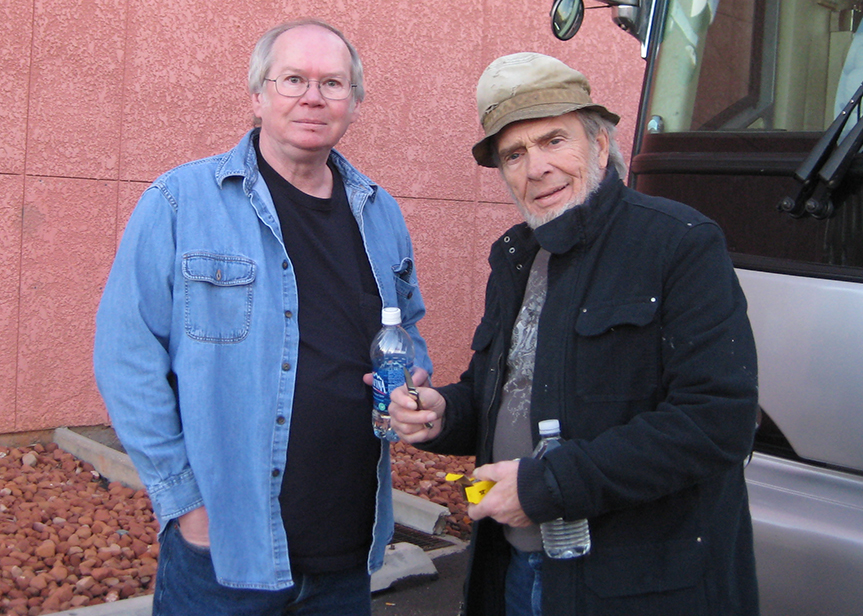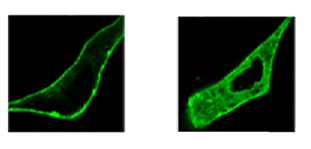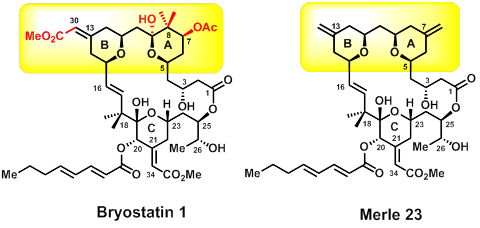Gary Keck and Bryostatins
Answer: Chemistry, music, and golden retrievers. Question: What are some of Gary Keck’s passions?
 |
| Professor Gary Keck with musician Merle Haggard, after whom Keck has named several compounds |
We didn’t get to golden retrievers, but music – especially country music, and especially
that of Merle Haggard – surfaced a few times in my chat with Gary Keck, Distinguished
Professor of Organic Chemistry here at the U, and 2014 Arthur C. Cope Scholar Award
recipient. I found that one needn’t look hard to find a little music/chemistry cross-pollination
in Keck’s work: his efforts to synthesize the natural products known as bryostatins
have led to a series of analogues that he’s dubbed "Merle compounds."
But there’s nothing frivolous about Merles, or bryostatins. Bryostatins are compounds
found in marine organisms – tiny filter-feeders known as bryozoans – that have been
thought for decades to have cancer fighting potential. More recently, they’ve shown
signs of possible effectiveness against HIV and Alzheimer’s disease. However, the
flagship compound, bryostatin 1, required tons of marine animals to yield just grams
of the compound, hence efforts by researchers like Keck to provide access to these
materials by total synthesis. Here Keck and his group provided a new asymmetric pyran
synthesis termed "pyran annulation", as well as an effective overall strategy for
bringing together two complex subunits using this process. In 2011, Keck and his co-workers
achieved the first total synthesis of bryostatin 1.
 |
|
Translocation of fluorescently tagged |
To illuminate the connection between bryostatin activity at the molecular level and
biological responses at cellular and higher levels, Keck notes the importance of studying
analogues. His group has shown that small variations in bryostatin structure can lead
to very different cellular responses. For example, fluorescently tagged PKCs can be
watched as they translocate within a cell, in response to different activators. Translocation
differences, in conjunction with other kinds of detailed biological characterizations,
can help in deconstructing processes that Keck likens to a Rube Goldberg machine.
Though in this case it’s more like a “twenty-story building full of Rube Goldberg
machines, all interacting with each other,” Keck says.
 More analogues means more tools in the toolbox for tinkering with that machine; enter
the Merle compounds. Keck and his team have synthesized these bryostatin kin with
various simplifications and substitutions. An example is Merle 23, another potent
PKC binder, which has a similar structure to bryostatins but gives biological responses
more like those of a phorbol ester. Its structural differences from bryostatin 1 help
to identify which features of that molecule are responsible for the distinctive biology
associated with bryostatin 1.
More analogues means more tools in the toolbox for tinkering with that machine; enter
the Merle compounds. Keck and his team have synthesized these bryostatin kin with
various simplifications and substitutions. An example is Merle 23, another potent
PKC binder, which has a similar structure to bryostatins but gives biological responses
more like those of a phorbol ester. Its structural differences from bryostatin 1 help
to identify which features of that molecule are responsible for the distinctive biology
associated with bryostatin 1.
While I digest this overview from Prof. Keck, he browses for images on his computer
to show me models of bryostatin/Merle variations and micrographs of tagged-PKC translocation
results. Along the way, he proudly displays photos of his all-access pass to Merle
Haggard shows, and of him and Merle in front of Merle’s touring bus. "He calls me
'ol’ Gary'. Which, by the way, is not the same as ‘old Gary'.”
I imagine ol' Merle is pleased to have namesake compounds that may someday unlock
treatments of cancer, HIV, or Alzheimer’s.
